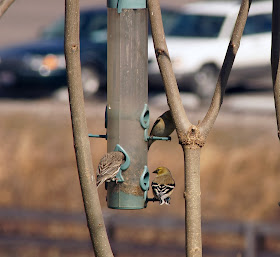Try doing Ornithology classes in sub zero temperatures. Students hate it, but this week has been good. This is only the second time we've included the winter season as part of the class. Last year it was Evening Grosbeaks and Red-breasted Nuthatches. This week we have Purple Finches and Tree Sparrows. I wouldn't say these birds are really rare for down here, but they are uncommon, and worth taking note.
Tree Sparrows
Lake Snowden has been bitter cold this past week. One new bird, a Red-headed Woodpecker certainly made it worth the visit. We get all the other woodpeckers on a regular basis down here, but this one takes a special trip to find. Thanks to Tiffany Kieffer for the above photos. She took the woodpecker with a cell phone up against the back of her binoculars.
Thanks to Bob Placier, Lynn Holtzman, and Ron Cass for spreading the word around campus about the following species they found out front this afternoon. This is a group of Horned Larks.
Horned Larks are recognized by the yellow chin, a black medallion or "bling" around the neck, and a thick Sam Elliot/Vigo Mortensen mustache. You can always click on the photos for a better look.
Jim McCormac did a great post on these guys earlier this week at ohio birds and biodiversity. Not only are his pictures better, he had thousands of birds. We have less than 100. So by no means am I trying to copy Jim's post in any way, I merely want people of Athens County to know, these birds are down here too!!
Jim found cracked corn to be an attractant to the birds he observed. Here we use something different. Though unintentional, freshly spread horse manure brought the birds in.
Without a telephoto lens, I had to, (as usual) sneak up on the birds. While most searched for seeds in the manure, a few remained up on the snow and ice standing guard. Whenever I got too close, they would peep and all fly away.
The main reason I grabbed the camera was to find this brown bird. It's a Lapland Longspur, and it's also the first time I've seen one. Yeah, a lifer for me! These are in winter plumage and look sparrow like. Their facial markings are different, but I looked for the reddish brown or rufus colored bar on the wings. A few of the males were already showing that same color on the nape, or back of the neck.
While it's always great to mark another new bird onto the list, I'd rather watch their behavior. It was entertaining to see how several at a time would waddle through the snow like ducklings, form a semi-circular pattern, and then hunker down in the snow.
Can you pick out the third species from this group? Look on the right. About 50% of the birds today were made up of Snow Buntings. While they would feed with the other two species, after taking flight, they would roost in trees separate from the others. I couldn't get any on the ground, as they were even more wary of my approach. Their bright white undersides, and white wing patches make them easily distinguishable. They contain a lot of buff color on them now, but will turn a brilliant black and white come breeding season. All three of these species will breed far north of Ohio.
Carolina Chickadee. I had a student lend me his 200-400mm zoom lens today. I won't say who, as I don't want everyone bugging him about his camera. I have used 400 telephotos before, but never a zoom lens. Took awhile to get used to. It was frigid cold, very windy, and I didn't use a tripod. These were mostly at 200. By the time I figured out how to use it at 400, I was frozen. Want some more excuses?
House Finch male
Goldfinch and House Finch female.
Downy Woodpecker male and female.
Red-winged Blackbird. Yep they are back, at least the males. Expect the females to arrive in a couple weeks.



















No comments:
Post a Comment